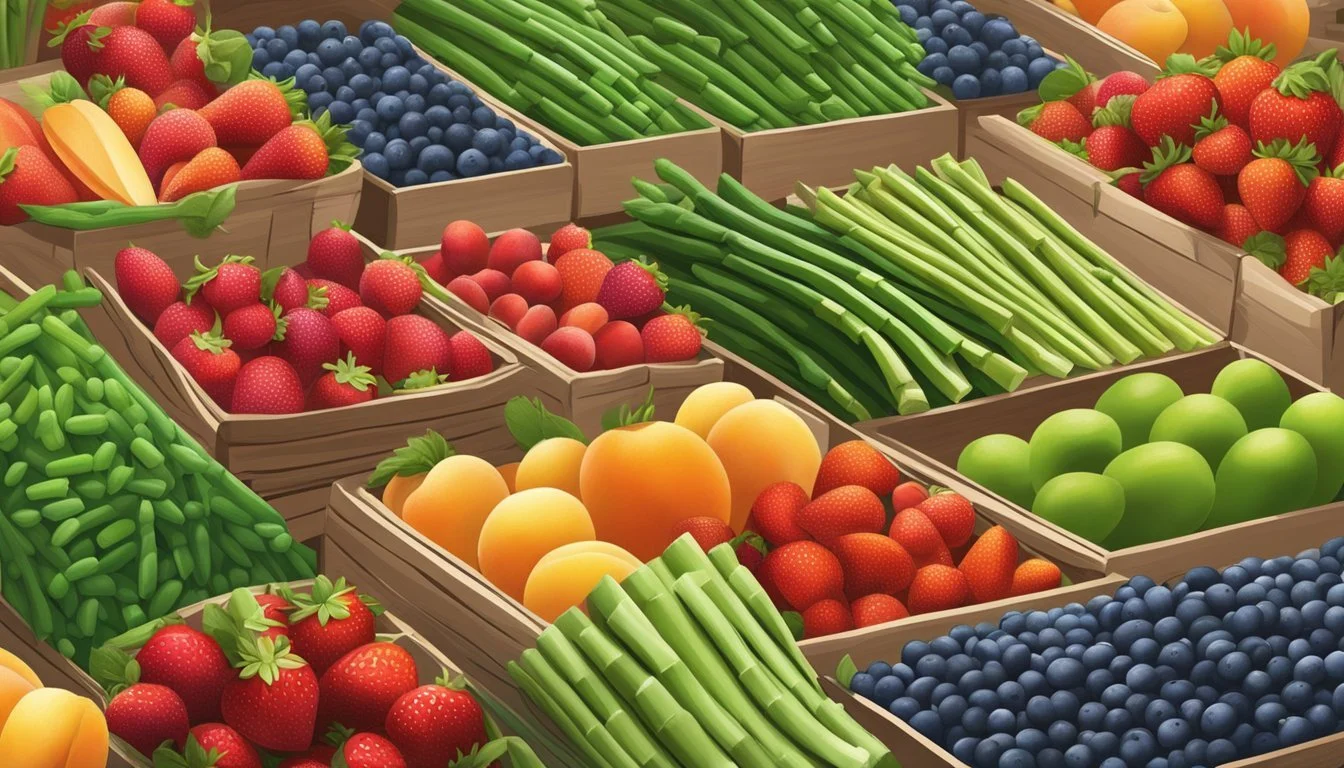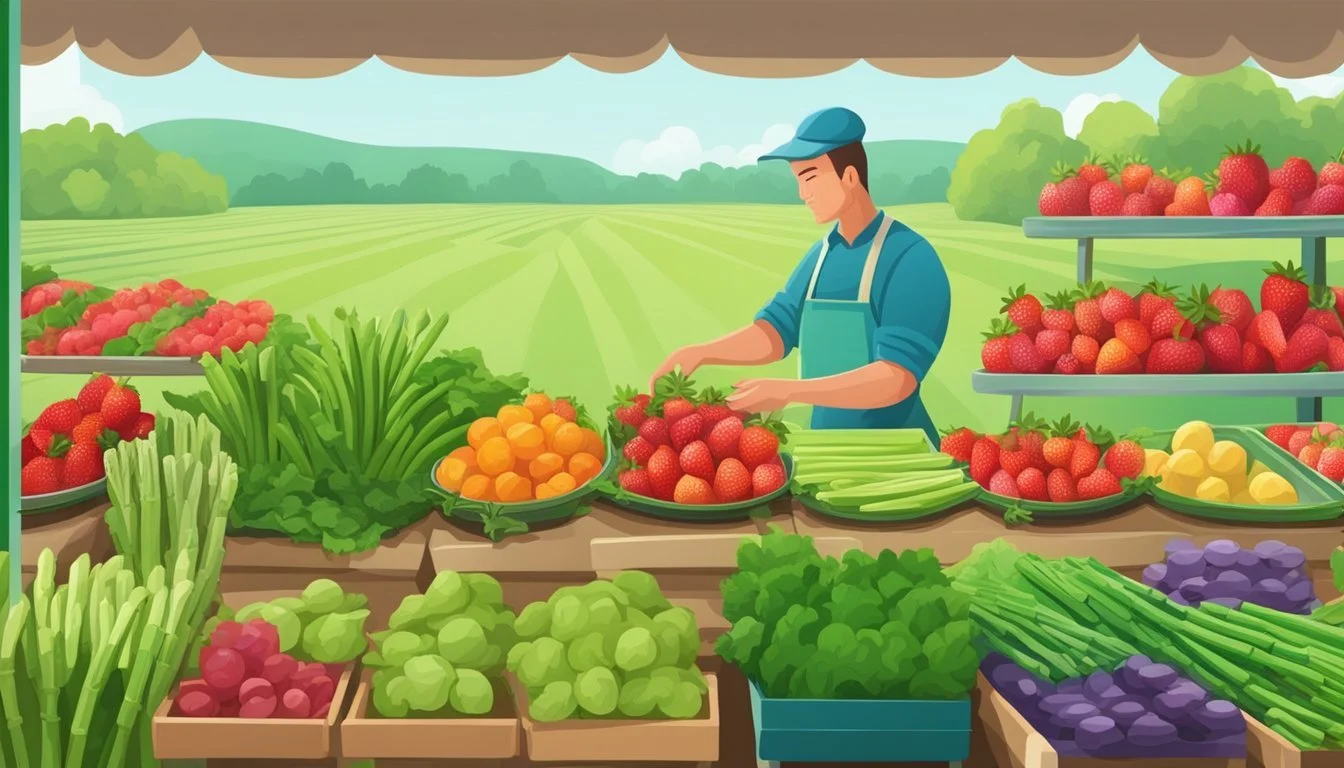Indiana Seasonal Fruit & Vegetables in May
A Guide to Fresh Produce
This Article is Part of our Indiana Seasonal Fruit & Veg Calendar
Indiana's agricultural landscape shifts with the seasons to offer an array of fresh fruits and vegetables. As the calendar turns to May, the state flourishes in greenery, marking the arrival of staple crops. May in Indiana signals the beginning of a fruitful period, welcoming a diverse harvest that captivates both the palates and plates of those seeking fresh, local produce.
During this month, farmers' markets and roadside stands start to showcase an abundance of seasonal produce. Shoppers can find a variety of greens such as lettuce and spinach, tender spears of asparagus (how long does asparagus last?), and the first harvest of sweet strawberries. Rhubarb also peeks through as a tart herald of the warmer months to come. The crop variety continues with radishes adding a peppery crunch, and the delicate flavors of green garlic and garlic scapes become widely available.
Gardens across Indiana come alive in May with the promise of the upcoming summer bounty. The preparation and planting done by local farmers in earlier months culminate in the form of vibrant produce beginning to reach maturity. This seasonal shift not only supports Indiana's local agriculture but also encourages healthy eating through fresh and nutrient-rich foods that are at their flavor peak.
Seasonal Overview of May
May in Indiana marks a vibrant transition within the agricultural season, where the chill of spring begins to give way to the warmth of summer, and fresh produce becomes readily abundant.
Spring Harvest in Indiana
During the month of May, Indiana's fields and farms flourish with a variety of fruits and vegetables. With the spring weather providing ample rainfall and moderate temperatures, crops such as asparagus and artichokes (What wine goes well with artichokes?) reach their peak. Berries begin to make their appearance too, with strawberries often ready for harvest, providing a burst of sweetness that's eagerly anticipated by local consumers. The following list gives a snapshot of produce typically in season:
Vegetables: Asparagus, Artichokes, Leeks, Radishes, Carrots, Peas
Fruits: Strawberries
Understanding Seasonality
Understanding seasonality is crucial for appreciating the ripeness and flavor of local produce. In-season fruits and vegetables not only taste better, but they require less transportation and storage, which can significantly reduce their environmental footprint. May's mild weather conditions contribute to the growth of spring crops, ensuring that the produce is at its freshest and most nutritious. Consumers seeking the best in flavor and sustainability should look for these seasonal offerings at local markets.
Key Fruit Highlights for May
May in Indiana marks an exciting time for fruit enthusiasts, as this month brings the onset of berry season and offers early indicators of the stone fruit harvest.
Berry Varieties and Ripeness
Strawberries: Indiana's strawberry season starts to bloom in May. The ripe, red, and juicy strawberries are typically ready for picking towards the end of the month, marking the beginning of berry season in the state.
Other Berries: While strawberries take center stage, other berry varieties are on the cusp of ripeness. May sees the earliest signs of blackberries and blueberries, hinting at the abundance that June will bring.
Stone Fruits and Early Indicators
Cherries (how long do cherries last?): As for stone fruits, May introduces the early blossoming of cherries. The cherry trees begin to show signs of the coming harvest, with the first fruit varieties expected to ripen towards the end of the month.
Rhubarb: Although not a stone fruit, rhubarb is also noteworthy. Its tart stalks are in full vigor and available throughout May, often used in combination with early strawberries for pies and preserves.
Featured Vegetables for May
May in Indiana brings a bounty of fresh vegetables to the table. Gardeners and farmers markets begin to showcase a vibrant selection of produce perfect for spring meals.
Leafy Greens and Salad Fixings
In May, lettuce, spinach, and kale reach their peak, offering crisp textures and varied flavors for salads and sandwiches. They are rich in vitamins and can be used in a variety of dishes:
Lettuce: Ideal for salads and wraps; varieties include Romaine and leaf lettuce.
Spinach: Versatile for both raw and cooked dishes; a great source of iron.
Kale: Known for its hearty leaves; excellent in sautéed or baked preparations.
Root Vegetables and Tubers
Although many associate the root vegetables with fall and winter, certain varieties like radishes and onions are springtime favorites in Indiana:
Radishes: They offer a peppery bite and are often enjoyed raw; can be sliced for salads or served as a crunchy garnish.
Onions: Essential for flavoring a multitude of dishes; spring onions are milder and can be used both raw and cooked.
Cruciferous and Stem Vegetables
Stem vegetables like asparagus are at their best in May, and the cruciferous family starts to come into season as well:
Asparagus: A perennial favorite known for its tender spears; it can be grilled, roasted, or steamed.
Peas: Fresh garden peas begin to appear; they add sweetness and texture to salads and side dishes.
Overall, the abundance of fresh produce in May provides an excellent opportunity to explore new recipes and enjoy the flavors of the season.
Planting and Harvesting Tips
May in Indiana is a crucial month for gardeners and agricultural enthusiasts, marking a period where soil preparation and the planting of early summer crops take precedence. As temperatures warm, it's essential to focus on proper techniques for planting and to know the best practices for harvesting and storage to ensure a bountiful season.
Soil Preparation and Planting Techniques
Before planting, one should ensure soil is well-aerated and moist, as this is critical for seedlings to thrive. Local farmers markets often provide high-quality seeds suited to Indiana's climate. When planting:
Carrots: They can be sown directly into the ground as soon as the soil can be worked on. Plant seeds 1/4 inch deep, spacing them 2-3 inches apart in rows that are at least 1 foot apart.
Broccoli: Starter plants should be spaced 18 inches apart to give room for growth. Planting them now ensures a harvest in early June.
Cantaloupes (how long does cantaloupe last?): Consider starting seeds indoors or buying seedlings from a local farmers market to transplant after the last frost date when the soil has warmed sufficiently.
Harvesting and Storage Recommendations
Once vegetables reach maturity, they should be harvested promptly to maintain their flavor and nutritional value. Post-harvest, options such as canning, freezing, and drying are suitable methods to prolong the enjoyment of May's bounty.
Carrots: They can be harvested when they reach the desired size and should be stored in a cool, dry place; they are also ideal for freezing.
Broccoli: Cut the central head before the flower buds open fully for the best taste; it's best consumed fresh or can be stored through freezing.
For those who grow an excess, local farmers markets offer an opportunity to share their harvest with the community, promoting local produce and sustainability.
Local Markets and Produce Availability
In May, Indiana's local markets brim with fresh, seasonal produce. Consumers seeking quality and freshness often turn to farmers markets for their grocery needs this time of year.
Finding Local Farmers Markets
Indiana's local farmers markets become vibrant community hubs in May. They are typically held weekly and can be found throughout the state, offering a variety of fresh produce. The following are notable markets shoppers may visit:
Bloomington Community Farmers Market: Open Saturdays, featuring local produce and artisanal goods.
Indianapolis City Market: Home to numerous vendors, it provides a wide range of local produce during the week.
Shoppers can use the online resource SavorIN Season to locate other farmers markets and their operation hours.
Understanding Market Offerings
Market offerings in May are bountiful and include Indiana-grown fruits and vegetables at the peak of their seasonality. Here's a snapshot of what shoppers might find at local farmers markets:
Vegetables: Asparagus, lettuce, radishes
Fruits: Strawberries are a seasonal highlight
Patrons are encouraged to seek out recipes showcasing Indiana produce. Local vendors and market organizers often share methods of preparing the fresh ingredients available at their stands.
Seasonal Eating and Recipes
May in Indiana is ripe for enjoying a variety of fresh fruits and vegetables that are both nutritious and flavorful. These seasonal delights offer perfect opportunities for creating healthy recipes and exploring various preservation methods.
Healthy Seasonal Recipes
During the month, one can take advantage of strawberries, peas, and cherries, which are just a few of the many fruits and vegetables at their peak. Preparing a strawberry salad with a balsamic glaze not only highlights the sweetness of the fruit but also complements it with the zest of the dressing. For a heartier dish, one might consider a pea risotto that showcases the freshness of newly harvested legumes.
Strawberry Salad: Combine arugula, fresh sliced strawberries, and goat cheese, drizzling with a balsamic reduction.
Pea Risotto: Arborio rice cooked slowly with broth, fresh peas, Parmesan cheese, and a touch of butter to create a creamy consistency.
Preservation and Preparation Methods
Preserving seasonal produce allows enjoyment of these flavors throughout the year. Canning strawberries can lead to delightful jams and preserves, ensuring the taste of May is captured for many months to come. Freezing is excellent for peas and cherries, retaining their nutritional value and taste until they're ready to be thawed and added to recipes. Drying is another option, especially for herbs like cilantro, which can be used to season dishes long after their season has ended.
Canning: Use sterilized jars for strawberry jams, following safety guidelines to ensure long-term preservation.
Freezing: Blanch peas for 1-2 minutes, then cool and freeze in bags; pit cherries and store in freezer-safe containers.
Drying: Hang bundles of cilantro in a warm, well-ventilated area until completely dry, then store in sealed containers.
Agricultural Events and Activities
May in Indiana heralds a lively period for agricultural events, with an array of activities that include farm visits and educational tours. These events offer a chance for individuals to connect with local agriculture, experience the growth cycle of produce firsthand, and gain knowledge about agricultural practices.
Farm Visits and U-Pick Farms
Farmers Market: Visitors can expect to find a bustling farmers market scene in May, with markets often featuring freshly picked fruits and vegetables, including Indiana's famed fruit trees. The ripe produce available ranges from strawberries to early-season blueberries.
U-Pick Farms: Many farms open their fields to the public for U-pick experiences. Visitors have the opportunity to pick their own fresh fruits directly from the plants, enjoying the spring weather as they gather strawberries, blueberries, and the early blooms from fruit trees.
Educational Opportunities and Tours
Educational Tours: Several Indiana farms offer educational tours that provide an insightful look into the planting, nurturing, and harvesting of crops. These tours may focus on various aspects of farming, from sustainable practices to the intricacies of operating a modern agricultural business.
Seasonal Guides and Corn Mazes: Seasonal guides at local farms are available to explain the various stages of produce development, often accompanied by fun activities such as corn mazes. These activities are both educational and recreational, showcasing the state's agricultural diversity.
By engaging in these agricultural events and activities, visitors can deepen their understanding of where their food comes from and the importance of supporting local farms.









